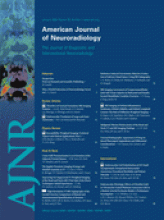Abstract
BACKGROUND AND PURPOSE: Microinvasive tumor cells, which are not detected on conventional imaging, contribute to poor prognoses for patients diagnosed with glioblastoma multiforme (GBM, WHO grade IV). Diffusion tensor imaging (DTI) shows promise in being able to detect this infiltration. This study aims to detect a difference in diffusion properties between GBM (infiltrative) and brain metastases (noninfiltrative).
MATERIALS AND METHODS: For 49 tumors (30 GBM, 19 metastases), DTI measures (p, q, L, and fractional anisotropy [FA]) were calculated for regions of gross tumor (excluding hemorrhagic and necrotic core), peritumoral edema, peritumoral margin (edema most adjacent to tumor), adjacent normal-appearing white matter (NAWM), and contralateral white matter. Parametric and nonparametric statistical tests were used to determine significance, and receiver operating characteristic (ROC) curve analyses were performed.
RESULTS: Mean values of p, L, and FA from regions of signal-intensity abnormality differed from those of normal brain in both tumors. The mean q value did not differ significantly compared with that in normal brain in any region in metastases or in adjacent NAWM of GBM. For GBM compared with metastases, q and FA were significantly lower in gross tumor (P < .001) and q was significantly lower in peritumoral margin (P < .001), which may be due to tumor infiltration. Significant overlap was present, which was reflected in the ROC curve analyses (area under the curve values from 0.732 to 0.804).
CONCLUSIONS: DTI may be used to help differentiate between GBM and brain metastases. The results also suggest that DTI has the potential to assist in detecting infiltrative tumor cells in surrounding brain.
- Copyright © American Society of Neuroradiology












